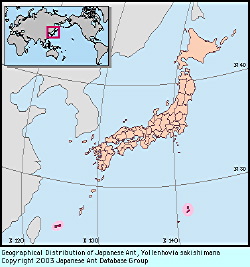
|
species
|
Vollenhovia sakishimana
|
 |
Japanese Name
|
Sakishima-umematsu-ari
|
Original Reference
|
|
Terayama, M. & Kinomura, K. (1998) Taxonomic studies of Japanese Formicidae, part 3. Genus Vollenhovia Mayr. Nature and Human Activities 2: 1-8.
|
Description
|
|
Total length of workers around 2 mm. Body color yellow to pale brown; antennae and legs yellowish brown. Head width/length ratio 0.83. Mandibles each with 6 teeth. Propodeal processes dentiform. Subpetiolar process large. Head, mesosoma, petiole and postpetiole shagreened; postpetiolar dorsum feebly sculptured and strongly shining; gaster and legs smooth.
|
Remarks
|
|
This species resembles V. emeryi, but can be distinguished from it as follows: (1) head without a median black spot just behind the clypeus; (2) anterior border of postpetiolar sternum almost straight in profile. This species nests in the soil or rotten wood in forests.
This is a polygynous; on average 3.8 queens are present per nest.
|
|

Distribution
|
|
Nansei Is (Sakishima Is), Ogasawara Is.
|
|
References
|
|
- Terayama, M. & K. Kinomura, K. (1998). Taxonomic studies of Japanese Formicidae, part 3. Genus Vollenhovia Mayr. Nature and Human Activities 2: 1-8.
|
Editor
|
|
Original text by Mamoru Terayama and Katsusuke Yamauchi. English translation by Mamoru Terayama, edited by Robert W. Taylor.
|
|